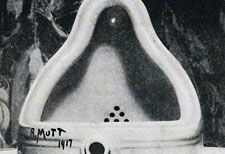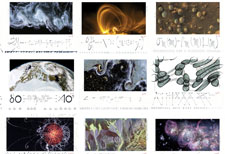
From Einstein to Eliasson
In the 1900s many new groundbreaking scientific theories emerged as artists experimented with time and space. Today, art is full of science. Artists help communicate science visually, examine the scientific worldview, and are often associated with research centres.
Discoveries and theories like Bohr’s atomic model, Einstein’s theory of relativity and the Big Bang didn’t just turn the world of physics on it’s head, but also the worldview of the common man. Time and space could no longer be understood as something static. From the 1900s to the present day, artists have also worked with shifts in time and space, just as science is gaining a greater space in the world of art, and vice versa.
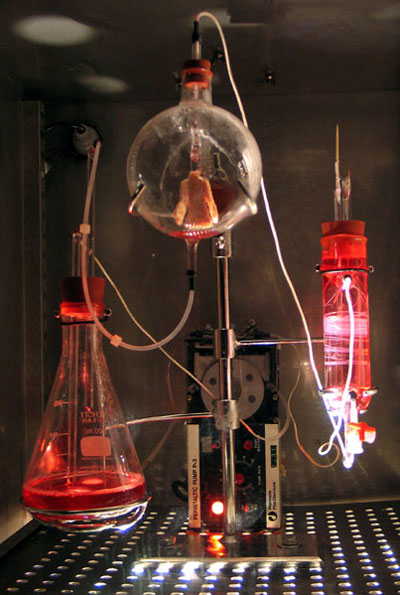
One of the most popular hybrids of art and science today is BioArt - a movement that examines ethical and societal implications of developments in biotechnology and medicine. The picture shows the work Victimless Leather (2004), a little leather jacket that has been created with cells from humans and mice. Image source: Oron Catts and Ionat Zurr
Today many artists adopt scientific methods, artists associated with scientific research help to distribute new findings visually, and in some cases artists have even contributed their own innovative discoveries in the scientific domain.
This is particularly the case with the artist and researcher Oron Catts, who heads the centre SymbioticA, where research is integrated into the world of art and art is used as an approach to research in biology.
In The Tissue Culture and Art Project, Catts and others were behind the experiments that belong to both the world of art and the world of science. The project focuses on the “Semi-Living”, cells that are kept alive outside the body. This has led to works such as the artificially produced steak Semi-Living Steak (2000), a leather jacket created in the laboratory (see illustration) and the creation of wings from cells from a pig - an experiment conducted at Harvard Medical School and exhibited at the Museum of Modern Art in New York (2000-1.)
Time and space
A wave of revolutionary discoveries and theories were made in the early 1900s. Niels Bohr’s atomic model was laid out in 1913, Einstein’s special and general relativity theories first saw the light of day in 1905 and 1915, and when a solar eclipse in 1919 suggested that there could be something to Einstein’s theory of relativity, it made the front pages.
"Man tries to make for himself in the fashion that suits him best a simplified and intelligible picture of the world; he then tries to some extent to substitute this cosmos of his for the world of experience, and thus to overcome it. This is what the painter, the poet, the speculative philosopher, and the natural scientist do, each in his own fashion. Each makes this cosmos and its construction the pivot of his emotional life, in order to find in this way the peace and security which he cannot find in the narrow whirlpool of personal experience.”
Einstein, Principles of Research, 1918
In addition, quantum mechanics (1925) appeared and in 1929 Hubble put forward his law based on observations of the expansion of the universe.
In the book Art and Physics (1991), the surgeon and author Leonard Shlain compared the transition from classical to modern physics with the new approaches to space and time that began to emerge in art. Dali painted melting clocks, just as Einstein’s theory of relativity contradicted Newton’s view of time and space as being constant. Where classical sculptures were built with a solid supporting base, you now saw sculptures like Alexander Calder’s hanging from the ceiling and spreading out into several pieces, only bound together by metal rods. Other sculptures were in constant motion and installation art offered new definitions of what a space could be. The Cubist artists were preoccupied with shapes and how you could see them from several angles at the same time.
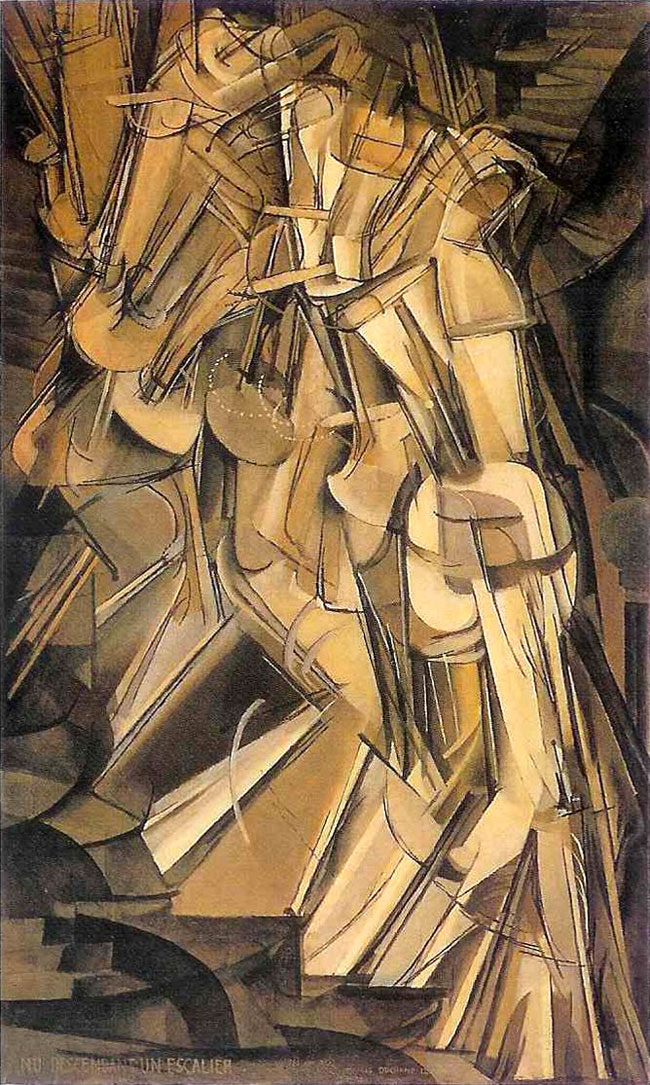 The French artist and author Marcel Duchamp’s work Nu descendant l’escalier No 2 (Nude descending a Staircase, No. 2) from 1912 can be seen as both Cubist and Futurist (many Futurist painters used dynamic images with a focus on movement and time). The space and the figure are fragmentary and it’s impossible to say where one ends and the other begins.
The French artist and author Marcel Duchamp’s work Nu descendant l’escalier No 2 (Nude descending a Staircase, No. 2) from 1912 can be seen as both Cubist and Futurist (many Futurist painters used dynamic images with a focus on movement and time). The space and the figure are fragmentary and it’s impossible to say where one ends and the other begins.
Duchamp was preoccupied with the relationship between natural laws and relativism in science. According to Duchamp, one should not take the laws of nature as absolute truth - the laws of nature we take for granted will be challenged by the discovery of new laws of nature. Here it is difficult not to call attention to the new dimension that Einstein’s theory of relativity gave to the understanding of time and space.
In addition to space being seen as something much more complicated with Einstein’s theory of relativity than through Newton’s classical physics, man was increasingly seen as something multidimensional and fragmented, rather than an individual as a single unit. While breakthroughs in science in the early 1900s revolutionised our view of nature, works of art like Duchamp’s are perhaps able to show what happens to human beings in this process - where man places himself in the scientific worldview.
The culturally created landscape
Toward the end of the 1900s and up to now, a growing number of artists have worked with science - both as interpreters of the scientific worldview and by incorporating their artistic activities into the research community.
An example of an artist who was interested in science and was especially well versed in subjects such as geology and biology was the American Robert Smithson (1938-73). In 1970 Smithson created the work Spiral Jetty, the best known work in the genre land art, a movement that was especially prominent in the 1960’s and 70’s in the United States.
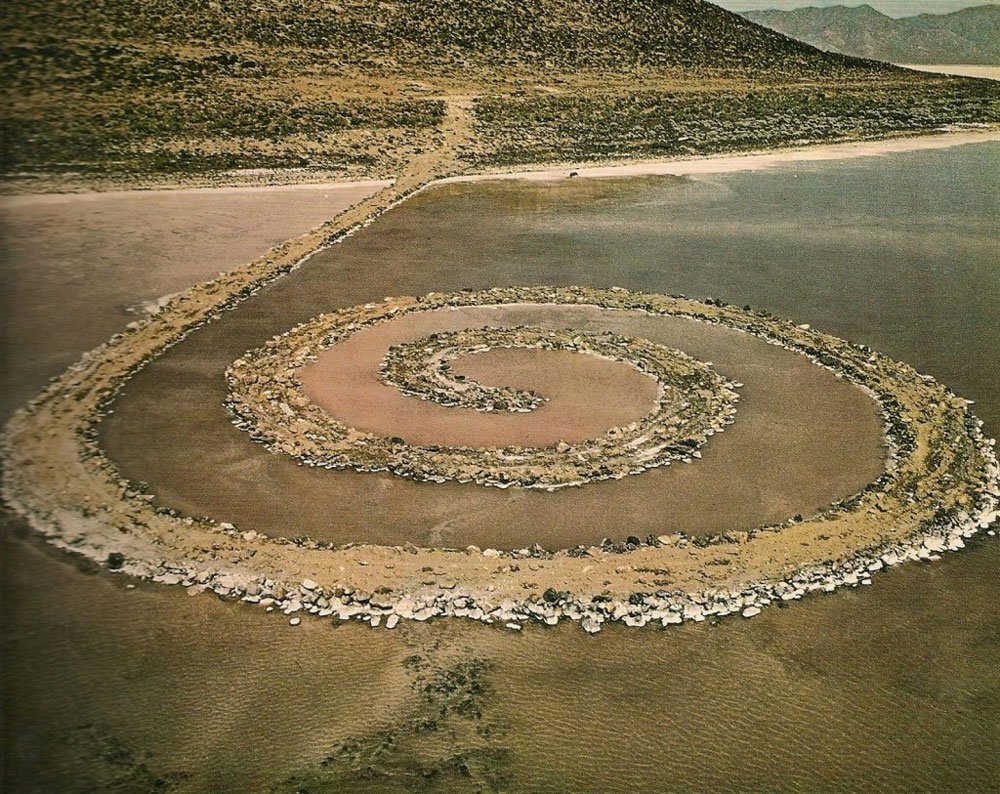
The 460 meter long Spiral Jetty, consisting of over 6000 tons of basalt stone and earth. This monumental work was created in two weeks using a frontloader, two trucks and a tractor. Spiral Jetty juts out into the Great Salt Lake, Utah.
In the traditional landscape painting, nature is often made safe and controllable by fixing something wild in place through brushstrokes, the motif can be adapted so that it is beautiful; it is framed and hung in homes or museums - symbols of culture. Artists associated with land art, by contrast, sought to take the art out of the museums, galleries and homes. The art should be specific to the place it was created and natural materials from the area were often used in the creation of the work.
The spiral could call to forms known from nature such as the inside of a conch shell, but the work is shaped by an artist. Spiral Jetty has changed the landscape it is part of, but was itself changed, particularly by the water level - in some periods the Spiral Jetty is above water, at other times below. It is not always possible to distinguish between ‘culture’ and ‘nature’.
While the relationship between the two polar opposites have rarely been black and white, it is especially characteristic of contemporary art that deals with nature, that it challenges that there has to be a dividing line between culture and nature.
Per Kirkeby’s rotunda
The same can be said about the significant and varied work of the Danish painter, sculptor, author and film director Per Kirkeby (b. 1938). Per Kirkeby is a trained geologist and has been on several expeditions to Greenland, where he has done field work and films as well as gathered inspiration for his art and his books.
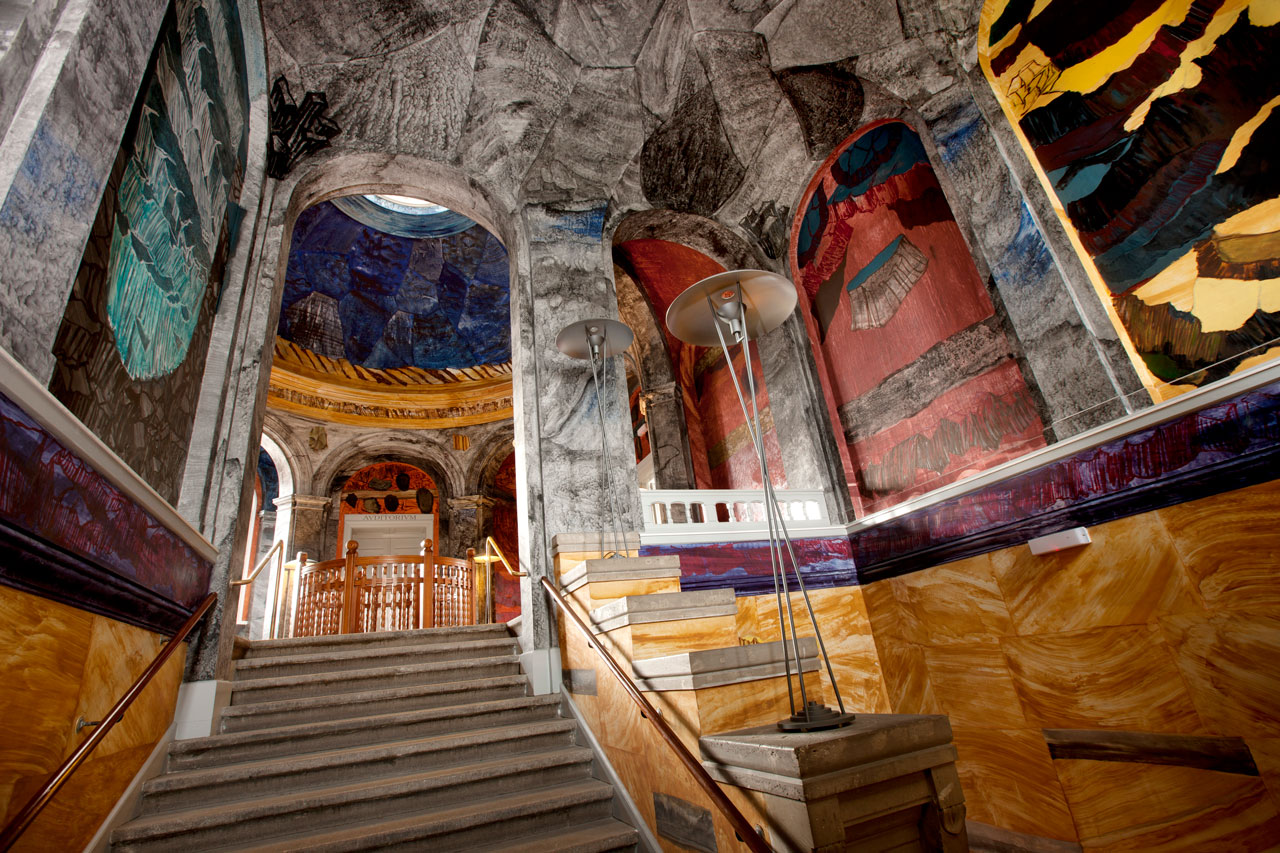
Image Source: Per Kirkeby and Statens Naturhistoriske Museum
One of the major projects Kirkeby has undertaken is the decoration of the rotunda in the Geological Museum in Copenhagen. Here you find elements such as the tectonic plates, the ice ages, runes, minerals, stone, rock falls and fossils which tell a story about geology and the scientific worldview.
The decoration refers not only to the Earth’s history told from a geologist’s perspective, but also the history of geology as a field. The Danish geologist, anatomist and theologian Niels Steensen (1638-1686), often called the founder of modern geology, is found lurking in many of the decorative structures. Steensen, or Steno, was behind groundbreaking discoveries and theories, such as the deeper you goes down into the ground, the older the layers that you find, that the shapes of Tuscan hills are due to underground movements and it was Steno who first introduced the concept of fossils.
The work also shows the doubt that is always present in scientific work for Kirkeby. For example, he had the rune inscription ”on Runamo in Blekinge” painted above the stairs.
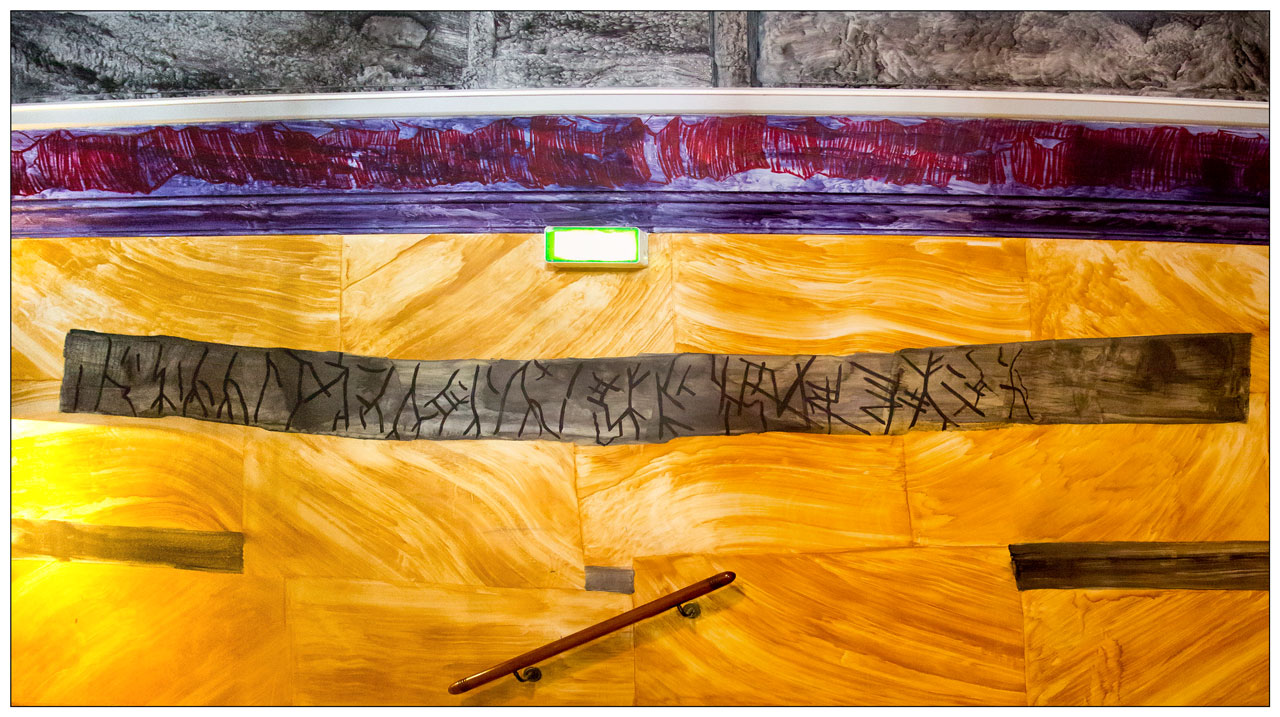
Image Source: Per Kirkeby and Statens Naturhistoriske Museum. Photo: Ola J. Joensen
There had long been theories about whether the runes told about the battle at Bråvalla, without anyone being able to decipher them. Others thought that it was just natural cracks in the rock. A team of scientists with different specialisations came to the conclusion that they were runes, and that, if you read them backwards, they told a little story about, among other things, Bråvalla - the battle and Norse gods. At a time when interest in the Nordic heritage was flourishing, the discovery attracted a lot of attention, and the team received great acclaim for their work. A young, critically minded archaeologist, Jens Jacob Asmussen Worsaae (1821-85) decided, however, to investigate the case himself and, after a visit to Blekinge, could make convincing arguments that the cracks were not man-made.
The decoration at the Geological Museum shows the geologist’s perspective from close studies of minerals, to terrestrial structures and a bird’s eye view of the Earth’s plate tectonics. At the same time, the process of scientific inquiry is included through references to theories that were previously believed, but have now been disproved, and theories like Alfred Wegener’s, which were ridiculed in the beginning, but are essential for geology today.
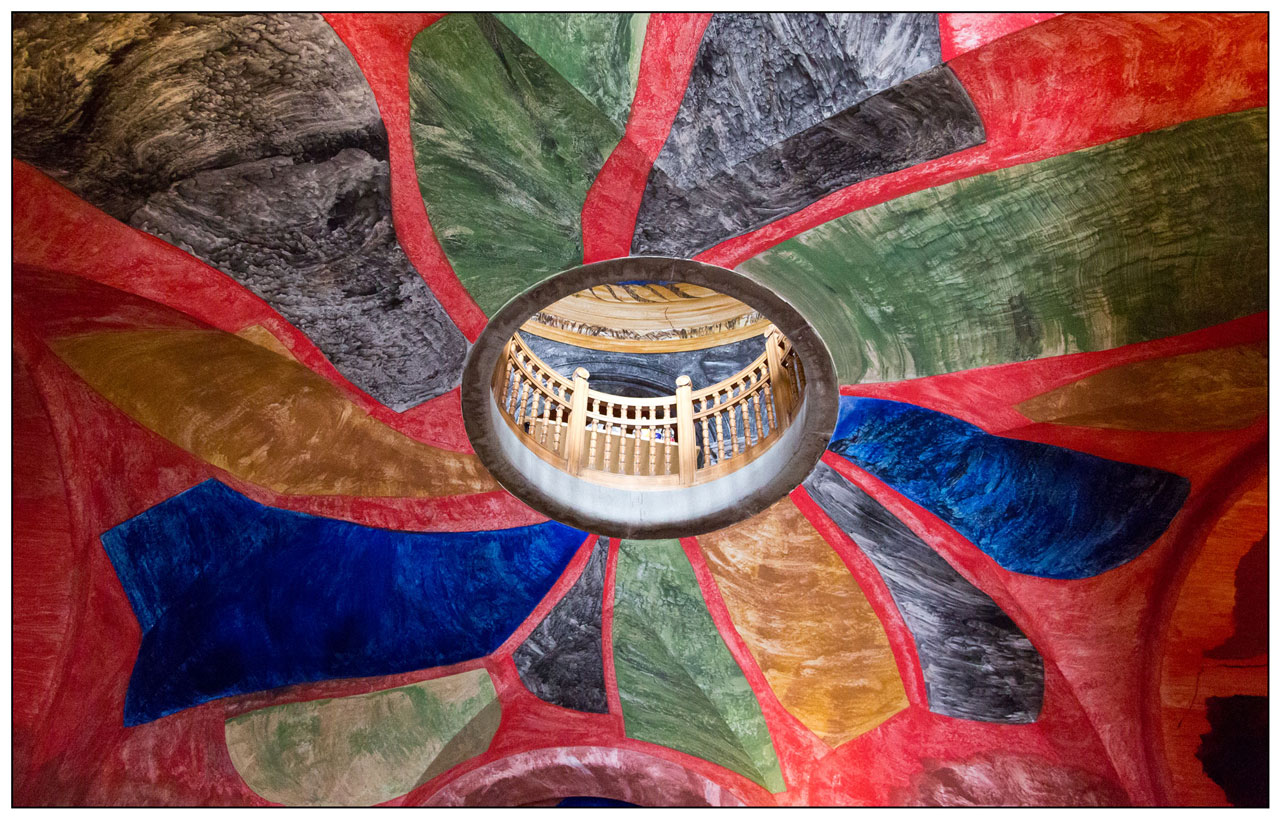
Image Source: Per Kirkeby and Statens Naturhistoriske Museum. Photo: Ola J. Joensen
In the cupola on the ground floor, several large fields plates extend up towards the opening. They are a reference to Wegener’s theory of continental drift, which was proposed after the First World War and gained recognition and acceptance in the 1960s. Continental drift is the theory that the Earth’s surface is made up of plates that shift in relation to each other, providing a mechanism for the changing appearance and position of the continents throughout the history of the Earth.
Many have pointed out that Kirkeby’s painting style can bring to mind Wegener’s plate tectonics, because Kirkeby paints layer-on-layer, in fields of different brushstrokes, colours and sometimes with elements such as rock formations, tree stumps, stones or motifs taken from, for example, the Byzantine image tradition. The viewer can then compose a personal experience and interpretation from these different elements. Just as the tectonic plates are in a constant state of flux, the reception of Kirkeby’s art is perhaps not so much a question of identifying this mineral, that rock formation, as much as it is the experience of the worldview we all form. Kirkeby shows both the perspective of the geologist, the scientific worldview, the artist’s interpretation of the worldview of his time - and how uncertain the foundation for a worldview can be. That scientific investigation, artistic interpretation and the interpretation of art are open processes.
Olafur Eliasson
This same approach can be found in the Danish-Icelandic artist Olafur Eliasson. Eliasson uses natural materials such as water, moss, lava rocks and algae, side by side with technology like spotlights, pumps and smoke machines.
Often his works are reminiscent of scientific experiments and it also happens that he uses methods from the sciences, such as in the work Green River, first featured in Bremen, Germany in 1998, and has since been exhibited in Moss in Norway, Los Angeles, Stockholm and Tokyo.
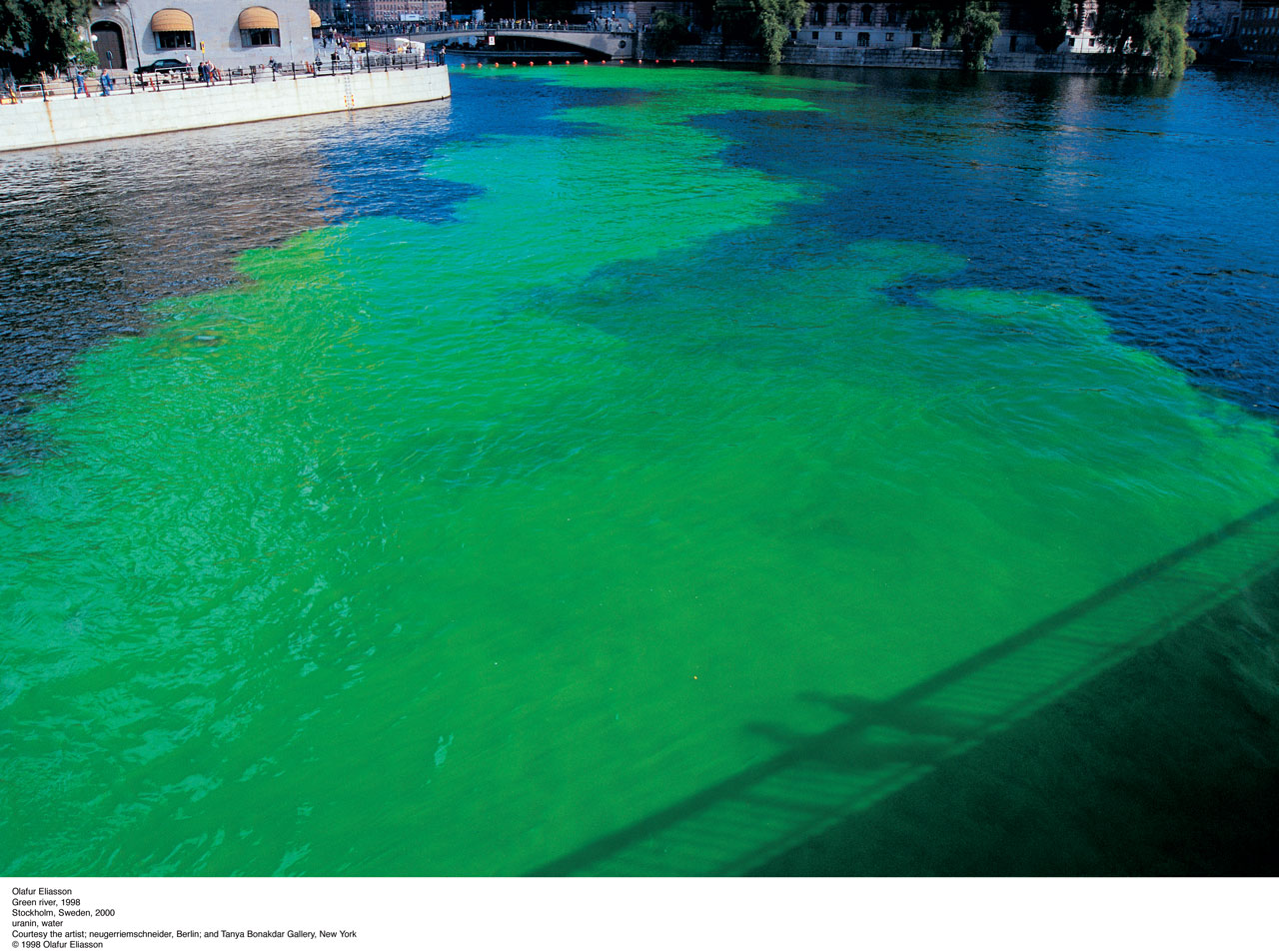
Image source: Olafur Eliasson
The neon green colour, which flowed down the canals of Stockholm in 2000, sparked strong reactions among the population. Some thought that there was some sort of natural disaster, while others thought it was a leak and the police several worried calls. The green colour was the innocuous substance uranin, a harmless dye that marine biologists use to study the flow of water.
In many of Eliasson’s works, things that are taken for granted are turned on their heads. Eliasson rarely hides the fact that the work is a construction – The New York City Waterfalls (2008), five large waterfalls erected in New York Harbour, for example, was built of scaffolding, which could be seen clearly behind the waterfalls. By viewing works of art, as well as other phenomena, as processes that can potentially be changed, art can be a form of dialogue. Green River, which provoked associations with environmental pollution and natural disasters, and which received significant press coverage, is just one example.
Models
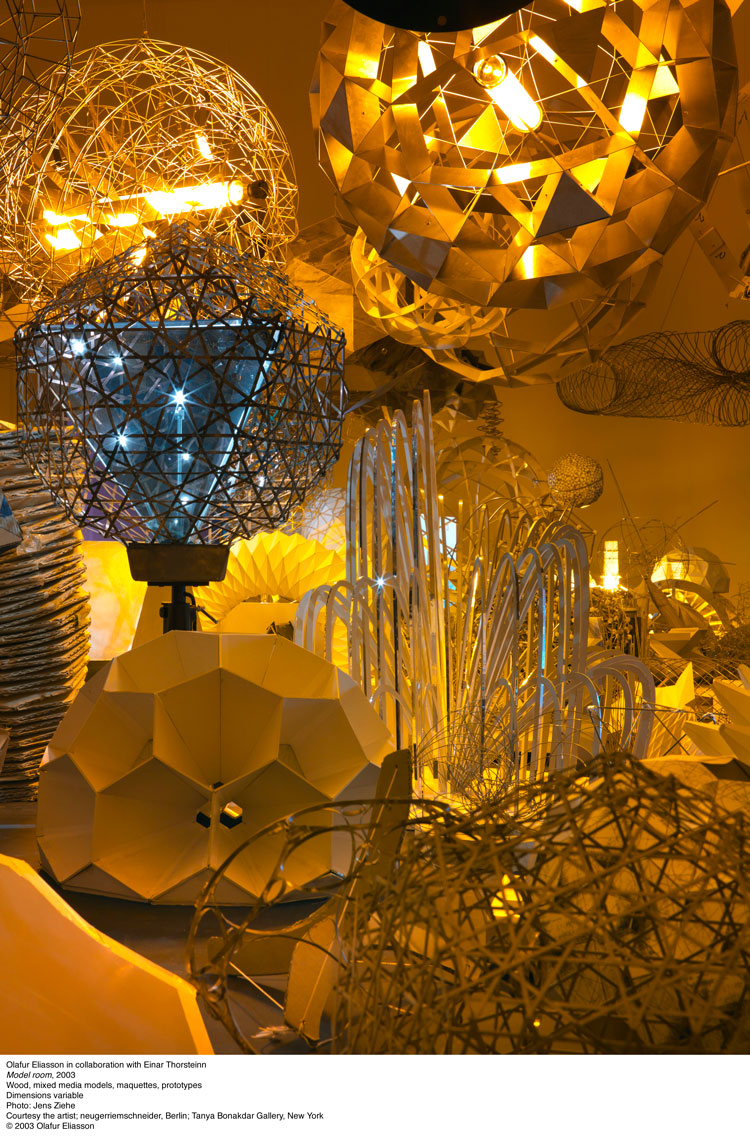
Image source: Olafur Eliasson og Einar Thorsteinn
With titles like Black Hole Lamp 2006, The Antigravity Cone 2003 and the many photo series where phenomena like rivers, coastlines, glaciers, caves and fault lines are documented, many of Eliasson’s
works draw our thoughts to the science domain. Equally interesting in relation to science, however, is the basic view from which Eliasson conceives his art.
In collaboration with the artist and architect Einar Thorsteinn, Eliasson created the work Model Room, first exhibited in 2003. The installation both returns to the tradition art has of using mathematics to formulate beauty, but is also very contemporary in terms of making the model visible.
Models are indispensable tools for science - when faced with concepts that can be difficult to visualise or with something that cannot be captured in a photograph, such as an atom, you can visualise the idea with a model.
"I want to strive toward exposing our blind spots, which is obviously a challenge since we don’t know exactly where they are. (...) Generally, we see a lot of research and experimentation being done in artists’ studios: Sometimes it’s teamwork, in a smaller or larger group; sometimes it’s carried out by a single person. This also happens at my studio. At times, the experiments are rather predictable, but the outcome might not be what we expected; it might be a spin- off, or take a new direction. It goes beyond the predictable into an uncertainty that’s unforeseeable.”
Olafur Eliasson, Studio Olafur Eliasson: An Encyclopedia, 2012
There are countless types of scientific models - everything from scale models showing smaller versions of something that would otherwise be impossible to get an overall view of, to models based on data, to conceptual models such as Niels Bohr’s model of the atom. Common to all models is that they represent something else.
The model can thus be seen as a medium or a negotiation, a visualisation or scaling that could potentially be done in many other ways. Model Room is a result of Eliasson’s and Thorsteinn’s many experiments with light, shapes and space. Often a model is a product of ideas and experiments. It then becomes a work of its own - an exhibition of the process, the experiment and the model.When different models are exhibited side by side with each other it should be noted that each and every one of them is only one experiment, one version - and suggests that there could be many others.
Wavelengths
Despite science’s nickname as “the exact sciences” we have repeatedly been shown how our view of nature is dynamic and changes over time. In the project Multiwavelength Milky Way, NASA shows how the Milky Way looks from 10 different wavelengths. Just as Duchamp’s figure and space was shown from several different vantage points, at several points in time – presented side by side, the different angles appear equally valid - the many perspectives compliment each other.
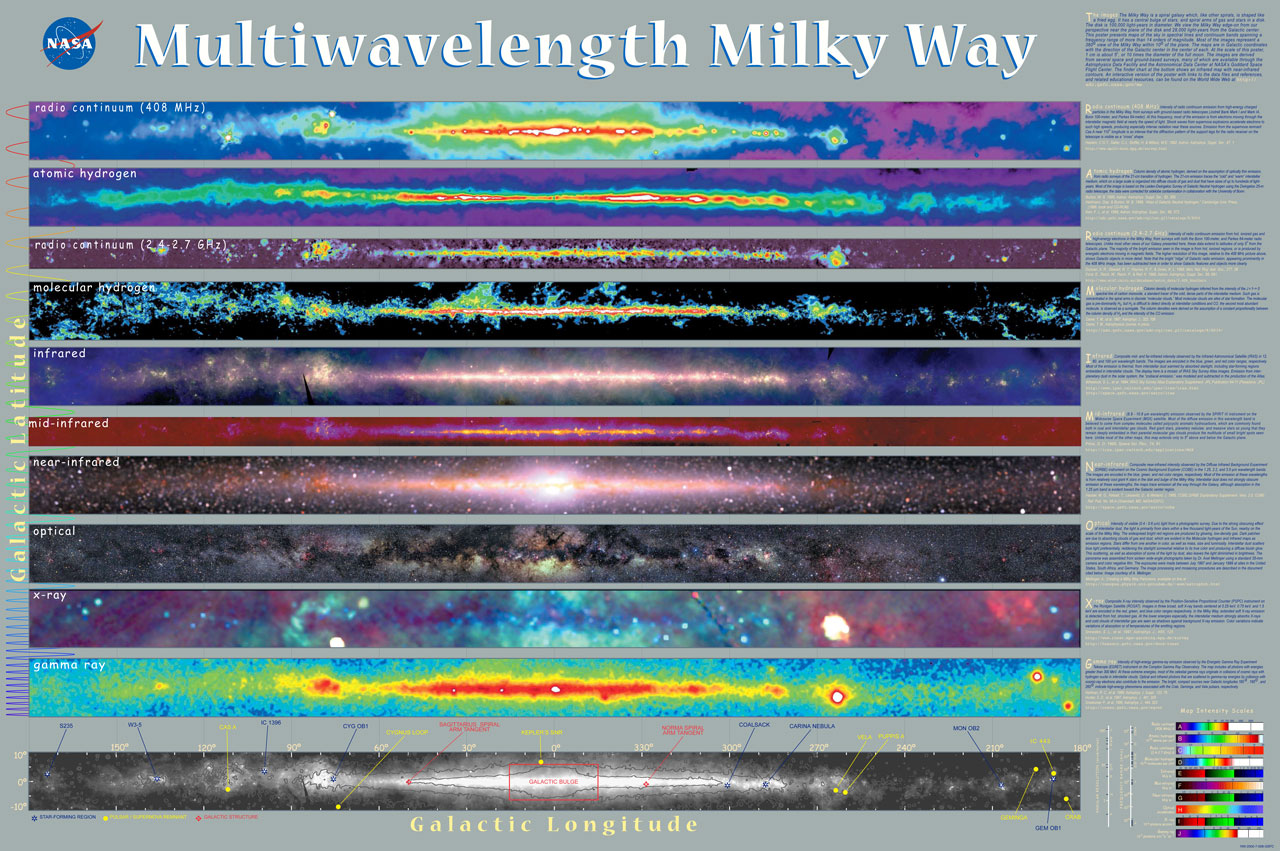
Image source: NASA
While science has retained the Enlightenment’s eager search for new knowledge and focus on communication, we are now less likely to believe that we will have definitive answers to the mysteries of the universe. Artists like Duchamp, Kirkeby, Eliasson and Catts, who incorporate the scientific worldview and scientific methods into their artistic experiments might be said to contribute to a scientific culture, where people are not afraid to think outside the box.
| << Previous |

